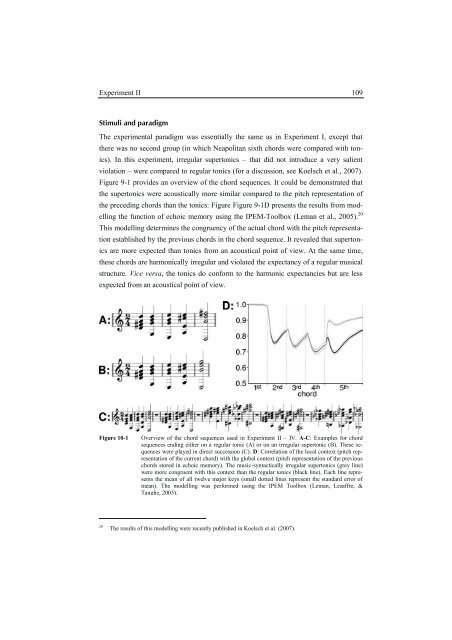Neural Correlates of Processing Syntax in Music and ... - PubMan
Neural Correlates of Processing Syntax in Music and ... - PubMan
Neural Correlates of Processing Syntax in Music and ... - PubMan
Create successful ePaper yourself
Turn your PDF publications into a flip-book with our unique Google optimized e-Paper software.
Experiment II 109<br />
Stimuli <strong>and</strong> paradigm<br />
The experimental paradigm was essentially the same as <strong>in</strong> Experiment I, except that<br />
there was no second group (<strong>in</strong> which Neapolitan sixth chords were compared with tonics).<br />
In this experiment, irregular supertonics – that did not <strong>in</strong>troduce a very salient<br />
violation – were compared to regular tonics (for a discussion, see Koelsch et al., 2007).<br />
Figure 9-1 provides an overview <strong>of</strong> the chord sequences. It could be demonstrated that<br />
the supertonics were acoustically more similar compared to the pitch representation <strong>of</strong><br />
the preced<strong>in</strong>g chords than the tonics: Figure Figure 9-1D presents the results from modell<strong>in</strong>g<br />
the function <strong>of</strong> echoic memory us<strong>in</strong>g the IPEM-Toolbox (Leman et al., 2005). 20<br />
This modell<strong>in</strong>g determ<strong>in</strong>es the congruency <strong>of</strong> the actual chord with the pitch representation<br />
established by the previous chords <strong>in</strong> the chord sequence. It revealed that supertonics<br />
are more expected than tonics from an acoustical po<strong>in</strong>t <strong>of</strong> view. At the same time,<br />
these chords are harmonically irregular <strong>and</strong> violated the expectancy <strong>of</strong> a regular musical<br />
structure. Vice versa, the tonics do conform to the harmonic expectancies but are less<br />
expected from an acoustical po<strong>in</strong>t <strong>of</strong> view.<br />
Figure 10-1 Overview <strong>of</strong> the chord sequences used <strong>in</strong> Experiment II – IV. A-C: Examples for chord<br />
sequences end<strong>in</strong>g either on a regular tonic (A) or on an irregular supertonic (B). These sequences<br />
were played <strong>in</strong> direct succession (C). D: Correlation <strong>of</strong> the local context (pitch representation<br />
<strong>of</strong> the current chord) with the global context (pitch representation <strong>of</strong> the previous<br />
chords stored <strong>in</strong> echoic memory). The music-syntactically irregular supertonics (grey l<strong>in</strong>e)<br />
were more congruent with this context than the regular tonics (black l<strong>in</strong>e). Each l<strong>in</strong>e represents<br />
the mean <strong>of</strong> all twelve major keys (small dotted l<strong>in</strong>es represent the st<strong>and</strong>ard error <strong>of</strong><br />
mean). The modell<strong>in</strong>g was performed us<strong>in</strong>g the IPEM Toolbox (Leman, Lesaffre, &<br />
Tanghe, 2005).<br />
20 The results <strong>of</strong> this modell<strong>in</strong>g were recently published <strong>in</strong> Koelsch et al. (2007).












